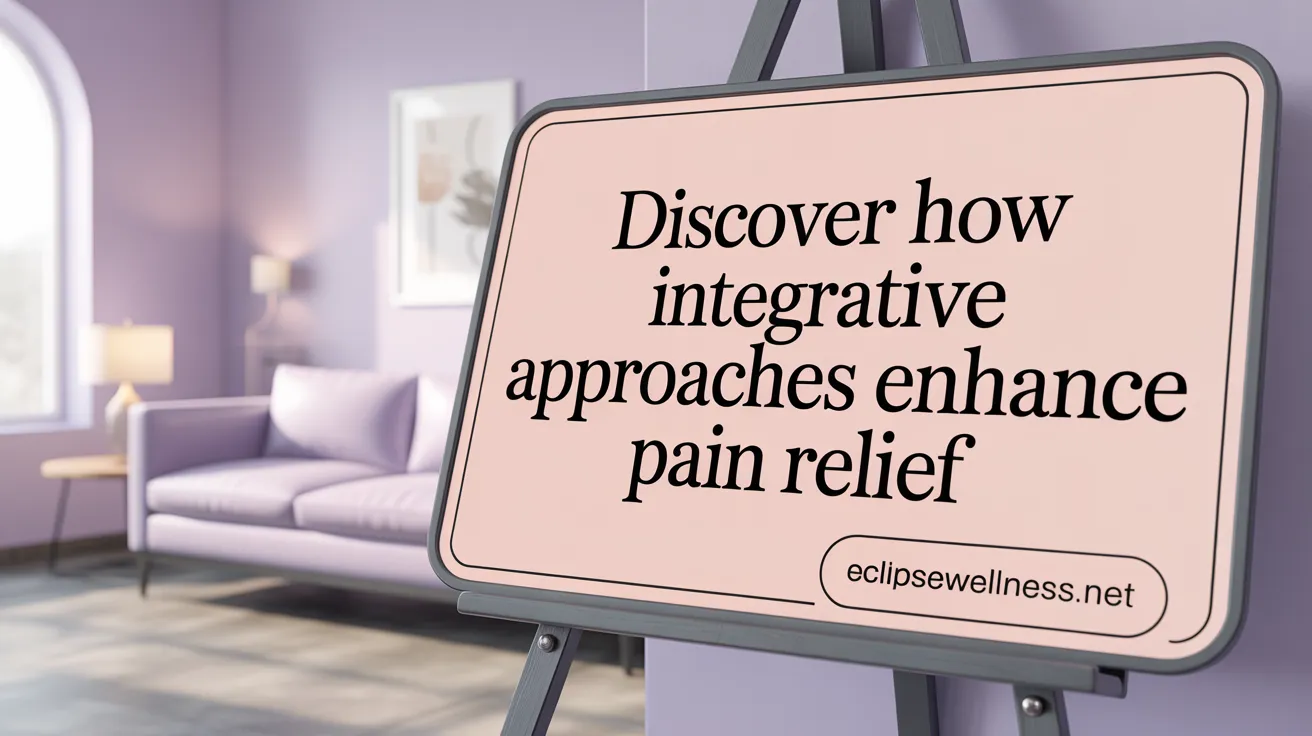Understanding Chronic Pain and the Need for Integrative Management
Defining Chronic Pain and Its Impact
Chronic pain is characterized by persistent pain lasting three months or more, often continuing beyond tissue healing. It affects over 50 million adults in the United States alone, causing significant disability and impacting quality of life. Beyond physical discomfort, chronic pain often leads to emotional challenges such as depression, anxiety, and stress, creating a complex cycle that heightens the perception of pain.
Limitations of Conventional Treatments
Traditional treatments for chronic pain commonly include medications like NSAIDs, acetaminophen, and opioids, physical therapy, and sometimes surgery. While these can provide relief, they often fall short of addressing the full scope of chronic pain’s causes. Medications may come with adverse effects or dependency risks, and some patients experience limited benefit from standard approaches, highlighting the need for broader strategies.
Embracing a Holistic Perspective
An integrative, holistic approach considers the physical, psychological, and emotional dimensions of chronic pain. This model incorporates non-pharmacologic therapies such as acupuncture, mindfulness meditation, massage, yoga, physical therapy, and nutritional support. By addressing lifestyle factors, emotional well-being, and mind-body connections, integrative management empowers patients towards improved function, reduced pain intensity, and better overall quality of life.
This comprehensive perspective supports personalized care plans that treat the whole person rather than isolated symptoms, enhancing long-term outcomes in chronic pain management.
Holistic Therapies: Evidence and Benefits in Chronic Pain Management

Overview of Complementary Therapies
Holistic or complementary therapies offer a supportive, nonpharmacologic approach for managing chronic pain by addressing physical, mental, and emotional well-being.
Key therapies include:
- Acupuncture: Involves inserting fine needles at strategic points to stimulate the nervous system and encourage natural healing.
- Massage therapy: Manipulates soft tissues to improve circulation, relax muscles, and reduce stress hormones.
- Yoga and Tai Chi: Combine gentle physical movement, breathing exercises, and mindfulness practices.
- Mindfulness meditation: Uses relaxation, breathing, and guided imagery to reduce stress and shift pain perception.
These therapies often integrate with conventional treatments in a patient-centered manner.
Scientific Evidence Supporting These Therapies
Research indicates that many complementary approaches demonstrate measurable benefits:
- Acupuncture shows consistent evidence for reducing chronic back and neck pain and the need for opioids, with moderate evidence supporting use in osteoarthritis pain.
- Massage therapy may provide short-term relief for low-back pain and fibromyalgia symptoms, though evidence quality varies.
- Mindfulness-based stress reduction and cognitive behavioral therapy effectively decrease pain intensity and improve physical functioning.
- Yoga and Tai Chi have strong evidence for reducing pain and improving function, especially in conditions like low-back pain and osteoarthritis.
- Music-based interventions can alleviate pain and associated depression.
These findings have led clinical guidelines to recommend such modalities as part of multimodal chronic pain management strategies.
Conditions Benefiting from Holistic Treatments
Numerous chronic pain conditions respond well to these complementary approaches, including:
- Low-back pain and neck pain: Acupuncture, massage, spinal manipulation, mindfulness, yoga, and Tai Chi show benefits.
- Osteoarthritis (especially knee or hip): Acupuncture, Tai Chi, and yoga are often recommended.
- Fibromyalgia and rheumatoid arthritis: Balneotherapy, omega-3 supplements, and massage may help.
- Headaches, migraines, and tension-type pain: Acupuncture and mindfulness practices can reduce severity.
Personalized treatment plans often combine multiple therapies tailored to specific needs.
Safety Considerations
Most psychological and physical complementary therapies carry a good safety profile when administered appropriately.
However, precaution is advised for certain populations, such as pregnant individuals or those with certain health conditions.
Herbal supplements may have side effects or interact with medications and should only be used under healthcare supervision.
Integrative approaches emphasize informed patient choice, close clinician-patient communication, and monitoring to minimize risks.
Holistic therapies, when combined judiciously with conventional care, support a comprehensive, compassionate, and effective approach to chronic pain management.
Conventional Pain Management: Approaches and Limitations

Common Conventional Treatments for Chronic Pain
Chronic pain is frequently managed using conventional therapies that include medications such as acetaminophen, nonsteroidal anti-inflammatory drugs (NSAIDs), opioids, and muscle relaxants. Interventional procedures like steroid injections, nerve blocks, and surgery are also common, particularly for severe or persistent pain cases. Physical therapy plays a central role by providing tailored exercises to increase strength, flexibility, and function, essential for restoring movement and reducing pain intensity. For more detailed information, see Conventional Treatments for Chronic Pain.
Benefits and Risks of Conventional Treatments
Medications often provide prompt relief and help control inflammation and pain, improving patients' ability to perform daily activities. Physical therapy enhances mobility, promotes healing, and can lead to sustainable pain reduction. However, risks exist; NSAIDs may cause gastrointestinal problems, and opioid use carries concerns of dependence, drowsiness, and other side effects. Surgical interventions, while sometimes necessary, come with risks inherent to invasive procedures and may not always guarantee long-term relief. Learn more about Pain Management Medications and Procedures.
Importance of Physical and Psychological Therapies
Psychological therapies such as cognitive behavioral therapy (CBT) and relaxation techniques are crucial in managing the emotional and mental aspects of chronic pain. These methods help patients develop coping skills, reduce anxiety, and reframe pain perceptions, complementing the effects of physical treatments. Combining physical and psychological approaches often results in better overall outcomes. Explore Cognitive Behavioral Therapy for Pain and Psychological Therapies for Chronic Pain.
Limitations and Exploration of Complementary Methods
Despite advances, conventional treatments may not fully address the complex nature of chronic pain, sometimes leading to limited effectiveness or adverse effects. These limitations have spurred interest in complementary and integrative approaches like acupuncture for chronic pain relief, massage therapy, mindfulness-based stress reduction, and yoga for pain relief. Such therapies target biological, psychological, and social dimensions of pain, aiming to provide holistic, personalized relief beyond symptom control. See more on Chronic Pain and Complementary Health Approaches and Integrative Pain Management.
Integrative Pain Management: Combining the Best of Both Worlds

What Are the Principles of Integrative Pain Care Combining Conventional and Holistic Methods?
Integrative pain management blends traditional medical treatments with evidence-based pain treatments. This approach recognizes chronic pain as a complex condition influenced by physical, emotional, and social factors. By combining both methods, integrative care aims to address not only the symptoms but also the root causes and the mind-body connection. It emphasizes patient-centered care, tailoring treatment plans to individual needs and ensuring coordinated interventions that work synergistically.
How Are Personalized and Coordinated Treatment Plans Developed?
Treatment begins with comprehensive evaluations that consider medical history, nutritional status, psychological wellbeing, and functional limitations. Healthcare providers collaborate across disciplines—including pain specialists, physical therapists, acupuncturists, and mental health professionals—to devise a plan unique to each patient. This plan integrates modalities such as medication management, physical therapy, acupuncture, and mindfulness practices, adapting over time based on patient progress and preferences.
What Are Examples of Combined Therapies Like Acupuncture with Physical Therapy?
Acupuncture, which stimulates nerves and releases natural pain-relieving compounds, is often combined with physical therapy exercises aimed at strengthening muscles and improving mobility. This synergy can accelerate recovery by reducing inflammation and enhancing functional capacity. Similarly, massage therapy paired with mindfulness meditation may relax muscles while calming the nervous system, addressing both physical tension and emotional stress.
What Evidence Supports Outcomes Such as Reduced Opioid Use and Improved Quality of Life?
Research shows that incorporating holistic approaches like acupuncture and yoga reduces pain intensity and supports physical function, lowering reliance on opioids and their associated risks. Patients report benefits including improved sleep, mood, energy, and mobility. Clinical guidelines increasingly favor nonpharmacological options as first-line treatments, underscoring the safety and effectiveness of integrative modalities in enhancing quality of life for chronic pain sufferers.
Lifestyle and Self-Management Strategies in Chronic Pain Care

How do lifestyle factors influence chronic pain management?
Lifestyle choices play a crucial role in managing chronic pain by addressing both physical and emotional well-being. A balanced diet rich in anti-inflammatory foods—such as fruits, vegetables, whole grains, omega-3 fatty acids, and nuts—can help reduce inflammation that often exacerbates pain. Regular physical activity, including gentle exercises like yoga, tai chi, and swimming, not only improves flexibility and strength but also promotes natural pain relief and supports mental health.
Quality sleep and effective stress management are equally vital. Poor sleep may intensify pain sensations, while relaxation practices including Mindfulness-based stress reduction and deep breathing calm the nervous system, lowering stress hormones and muscle tension.
What self-care tools support chronic pain relief?
Mindfulness and relaxation techniques empower individuals to actively manage pain's emotional impact. Practices like guided imagery, progressive muscle relaxation, and goal-setting help focus attention, reduce anxiety, and foster a positive relationship with pain.
Setting achievable goals through structured Self-management plans for chronic pain encourages patient engagement and sustains motivation. Educational resources and clinician support further enhance these efforts.
How does physical activity contribute to pain reduction?
Movement therapies — yoga, tai chi, swimming, and gentle stretching — are effective for conditions like osteoarthritis, fibromyalgia, and low back pain. They improve joint lubrication, muscle tone, balance, and posture, while stimulating the brain’s natural pain-modulation systems. These activities can be adapted to individual needs and delivered in person or via telehealth, promoting accessibility.
Can nutrition and supplements aid in pain management?
Nutrition plays an anti-inflammatory role in chronic pain care. Supplements like omega-3 fatty acids and vitamin D have evidence supporting their benefits in rheumatoid arthritis and fibromyalgia, respectively. While some herbal preparations (e.g., turmeric, boswellia) contain anti-inflammatory properties, patients should consult healthcare providers to avoid interactions and ensure safe use.
Together, these lifestyle and self-management strategies form an integrated foundation for chronic pain care, emphasizing a holistic , patient-centered treatment that nurtures mind and body.
Implementing Integrative Pain Management Programs: Models and Patient Experience
Examples of Holistic Chronic Pain Programs
Several established programs demonstrate effective integrative approaches to chronic pain management. For instance, the Cleveland Clinic’s Holistic Pain Management Program tailors patient plans incorporating acupuncture, chiropractic care, yoga, psychotherapy, nutrition counseling, and physical therapy. Similarly, the People’s Community Clinic in Austin offers an integrative pain management program emphasizing biopsychosocial factors and trauma-informed care, involving acupuncture, behavioral health management, yoga, nutrition, and social support.
Multidisciplinary Teams and Collaborations
Successful integrative programs rely on multidisciplinary teams including integrative medicine physicians, acupuncturists, physical therapists, psychologists, nutritionists, yoga therapists, social workers, and primary care providers. Collaboration ensures comprehensive evaluations and personalized plans addressing physical, emotional, and social dimensions of pain, consistent with the biopsychosocial model for chronic pain.
Benefits of Trauma-Informed, Biopsychosocial Approaches
Addressing trauma and biopsychosocial influences recognizes chronic pain as multidimensional. Trauma-informed care builds trust and safety, facilitating better engagement and outcomes. This approach helps disrupt pain’s persistent stress cycle, enhancing emotional resilience and reducing pain intensity, as supported by integrative pain care strategies.
Patient Education, Group Classes, and Ongoing Support
Patient empowerment is central, with programs offering educational resources on nutrition, stress management, sleep hygiene, and self-management plans for chronic pain. Group classes such as yoga foster social support and accountability. Ongoing coaching and follow-up encourage consistency and adaptation of therapies, highlighted in self-management of chronic pain.
Challenges and Future Directions in Integrative Care
Barriers include limited insurance coverage and insufficient awareness among patients and providers. Future directions emphasize research validating therapies, standardizing protocols, expanding access especially via telehealth, and integrating technology to monitor patient progress. Advancing integrative care involves balancing personalized treatment with evidence-based pain treatments to optimize quality of life and functionality for those living with chronic pain.
The Future of Chronic Pain Care: Empowerment Through Integration
Embracing a Holistic and Conventional Partnership
Combining holistic therapies like acupuncture, mindfulness, and yoga with conventional medical treatments such as medication management and physical therapy creates a powerful synergy. This integrative approach not only targets pain from multiple angles but also reduces reliance on opioids, supports faster recovery, and improves overall well-being.
Putting the Whole Person First
Effective chronic pain care recognizes the complex physical, emotional, and social components of pain. Personalized, whole-person care tailors treatments based on individual health, lifestyle, and preferences, promoting mind-body harmony and addressing root causes rather than just symptoms.
Collaboration and Patient Engagement
Patients play an active role in their healing journey, empowered through education and shared decision-making with their healthcare teams. Open communication and partnership foster trust, helping patients navigate options and set attainable goals.
A Vision for the Future
Advances in research and clinical practice are expanding integrative models, offering more evidence-based options and wider accessibility. The future of chronic pain management lies in embracing personalized, integrative care that empowers patients to reclaim their lives with compassion and innovation.
